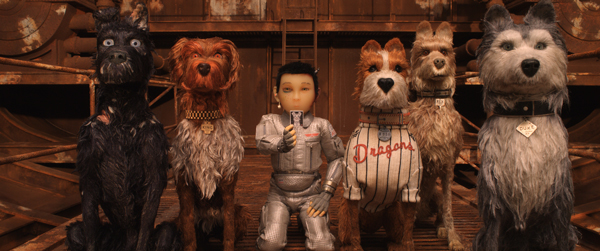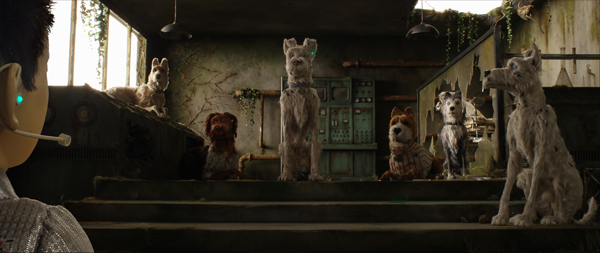In the dystopian future of Wes Anderson’s stop-motion animation Isle of Dogs, Megasaki City is gripped with the panic over the contagious dog flu. The nefarious Mayor Kobayashi (voiced by Kunichi Nomura) exiles all dogs to Trash Island, a place piled with the detritus of modern life, but his 12-year-old ward Akira (Koyu Rankin)) bravely flies there in a small plane to retrieve his own dog, Spots (Liev Schreiber). When Akira crash-lands, he’s rescued by five dogs who used to belong to someone and decide to help him.

What follows is a lot of snappy dialog and hilarious situations that play on both human foibles and traditional canine behavior. In one scene, Chief (Bryan Cranston), a dog who’s been stray most of his life, refuses to play “fetch” with Akira. Finally, he acquiesces, he says, “because I feel sorry for you.” In another scene former circus dog Nutmeg (Scarlett Johansson) performs one of the tricks she was taught—sans the spinning balls. In a stroke of high wit, Anderson has the dogs speak English so we understand them, while the humans speak Japanese—with occasional English translations offered by Interpreter Nelson (Frances McDormand).
Akira and the dogs gradually make their way towards a remote part of the island in search of Spots. Anderson has said that his inspirations were Japanese woodblock prints and old Japanese films. I also saw a bit of Joseph Conrad and “Heart of Darkness”, where the protagonist moves farther away from human civilization to danger and “no-man’s land” (double meaning intended). Except that what they find at the end of their journey is not only the horrible, but also the heart-warming.

Meanwhile, on the mainland, a group of scientists is working to find treatment for dog flu and its symptoms. (One of the scientists is Yoko Ono, who is voiced by—who else?—Yoko Ono.) An outspoken American exchange student, Tracey Walker (Greta Gerwig), is trying to rouse people together to fight Kobayashi’s conspiracy.
Isle of Dogs is Wes Anderson at his creative genius peak. His stop-motion takes advantage of the medium’s best qualities —the feeling of three dimensionality and of theatricality that comes from figures and landscapes that are clearly human-made but exist in a real space. Anderson directed and wrote the script, concocting a clever fable that melds Japanese traditional culture (taiko drums! kabuki!), Japanese pop culture, plus American pop culture to boot. The film has a serious side, too, touching on hot button issues such as the degradation of the environment, the pervasiveness of surveillance and control of popular opinion, and how easily we move into a police state when threats are perceived. Sound familiar?











0 Comments